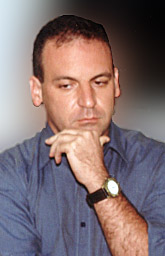
PhD in Chemistry, nowadays working as a Doctor Professor in the Chemestry Institute of the
Federal University Fluminense Universidade Federal Fluminense where he teaches Organical Chemistry.

 |
Carlos
Eduardo Martins Carvalho PhD in Chemistry, nowadays working as a Doctor Professor in the Chemestry Institute of the Federal University Fluminense Universidade Federal Fluminense where he teaches Organical Chemistry. |
| ON-
How did you start cultivating orchids? Which was the magic moment of attraction? CE- Since I was a kid, I always loved animals and plants, due to the kind of education I had, I think. My father loved orchids and he had some C. forbesii, C. intermedia, C. guttata, C. harrisoniana, etc, growing on trees or in tree-fern pots, however they have never got my attention. I remember that it was my grandmother's birthday and my mother decided to buy something from Florália. |
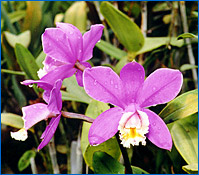 C. harrisoniana |
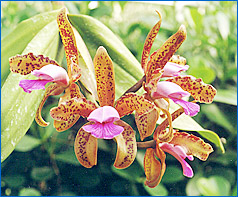 C. guttata |
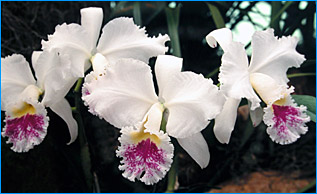 C. Sonia Altenburg |
When
we got there, there was an exhibition of the orchids from Mr. Rolf Altenburg's
collection. I was fascinated, amazed. The coloring and the scent of the flowers had attracted me. I don't need to say that the gift to my grandmother was an orchid and Rolf, a friend of my father, offered me another one as a gift. It was a Cattleya Sonia Altenburg. Since then, I started to cultivate orchids and look at my father's plants. |
| ON-
How long have you been cultivating orchids? CE- Since 27 years ago. I was ten years old when I got this first orchid. It is true that I have been kept away from orchids for a while, many times, but I always had someone to take care of my collection. |
| ON-
Where do you cultivate your plants? CE- Nowadays, there are placed in Iguaba Grande, in the Lakes region, in the state of Rio de Janeiro, in a 120m² green house covered with a plastic material and the sides are protected by a shading material. The place is well illuminated, rather dry and very windy. |
| ON-
How many plants do you have? CE - At about 2000 adult plants and 3000 seedlings. |
| ON-
Which orchids do you have more? CE- Hybrids of Cattleya, native Cattleya such warnerii and labiata and Laelia purpurata. I also have some Phalaenopsis and Dendrobium. 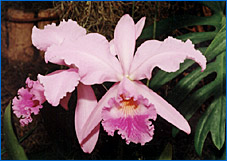 C. warnerii |
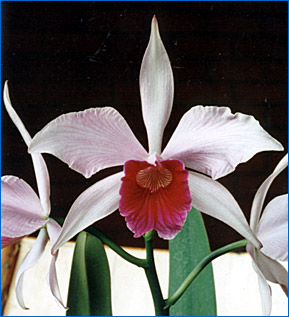 Laelia purpurata |
|
ON-
Between yours, what is the favorite plants? ON-
Do you prefer hybrids or species?
|
| ON-
Which
Brazilian genera do you have in your collection? CE- I have Cattleya, Laelia, Oncidium, Miltonia and even Pleurothalis. |
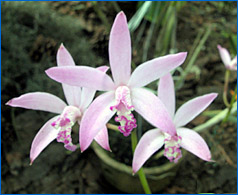 Laelia crispata |
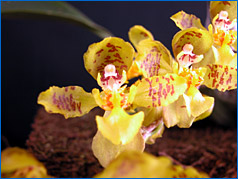 Oncidium cornigerum |
| ON-
How long do you spend taking care of your orchids, daily? CE- Unfortunately, just some hours during the week-end. ON- Besides this first attraction, was there another factor (person or an event) that influenced in your feelings regarding to the orchids ? CE- All the story about orchids and orchidophilia is fascinating. That goes without saying that it is one of the biggest families of vegetal kingdom. Two people have greatly encouraged me: my father and Mr. Rolf Altenburg. |
| ON-
Which are the climatic conditions found in your environments? CE- Tropical climate at the sea level. The place is dry and extremely windy which are not the best natural conditions. |
| ON- Do you have a cultivation tip to share with us? |
| CE-
Specialize in one genus or in genera that
have the same cultural requirements. All orchidists who try to cultivate
many different genera, generally, kill many plants. When I cultivate my
plants in Niterói city, my green house was too stuffy. |
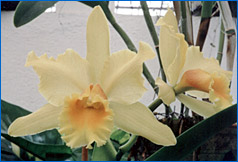 Blc. Castle Heritage |
From
11:00am to 1:00pm, during the summer, we could not stay more than 5 minutes
inside however, the plants grown and bloomed very well. The orchids have their own way to say if they are well or badly cultivated. Try to learn this language and the orchids will bring just joy. |
| ON-
Is there a short or an amusing story connected to orchids that you want
to tell us? CE- I always found a great contradiction in the practice of orchidophilia. Imagine a hobby that has started in England, during the XIX century. Soon after the exhibition of the first bloomed Cattleya labiata in this country, in a meeting in the Royal Horticultural Society, the firsts interested people appeared, the "orchidists". Hundreds of expeditions have been sent to Americas to collect orchids. Thousands of plants died due to the transportations and some other thousands due to the inappropriate cultivation in green houses which were not acclimated. If those people are the friends of the orchids, imagine what they could do with their enemies... Still today, the orchidists are the great responsible for the extermination of many species in their natural environment. I think that the societies have a great responsibility in the orientation of neophyte orchidists for not collecting or buying collected plants, in order to avoid the disappearance of our loved orchids in their natural environments. |
|
ON-
One said that orchidophilia is a soft manifestation of madness. Have you
done any "orchidophilic" insanity?
ON- Thank you, Carlos Eduardo |
| Photos:
Sergio Araujo Note: The orchids here presented are not from Carlos Eduardo's collection. They are here just for illustration. |
|
Any
kind of reproduction (print, digital or anyone other) of any type of
material of this
site - texts, lay-out, photos, images and others - is strictly forbidden without the previous written permission of the authors. Any solicitation or information should be done by the e-mail bo@sergioaraujo.com |